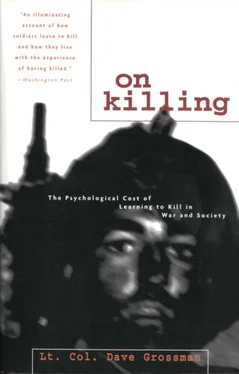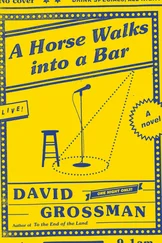One of the most powerful examples of the military’s success in developing conditioned reflexes through drill can be found in John Masters’s The Road Past Mandalay, where he relates the actions of a machine-gun team in combat during World War II:
The No. 1 [gunner] was 17 years old — I knew him. His No. 2 [assistant gunner] lay on the left side, beside him, head toward the enemy, a loaded magazine in his hand ready to whip onto the gun the moment the No. 1 said “Change!” The No. 1 started firing, and a Japanese machine gun engaged them at close range. The No. 1 got the first bunt through the face and neck, which killed him instantly. But he did not die where he lay, behind the gun. He rolled over to the right, away from the gun, his left hand coming up in death to tap his No. 2 on the shoulder in the signal that means Take over. The No. 2 did not have to push the corpse away from the gun. It was already clear.
The “take over” signal was drilled into the gunner to ensure that his vital weapon was never left unmanned should he ever have to leave. Its use in this circumstance is evidence of a conditioned reflex so powerful that it is completed without conscious thought as the last dying act of a soldier with a bullet through the brain.
Gwynne Dyer strikes right to the heart of the matter when he says, “ Conditioning, almost in the Pavlovian sense, is probably a better word than Training, for what was required of the ordinary soldier was not thought, but the ability to… load and fire their muskets completely automatically even under the stress of combat.” This conditioning was accomplished by “literally thousands of hours of repetitive drilling” paired with “the ever-present incentive of physical violence as the penalty for failure to perform correctly.”
* * *
The Civil War weapon was usually a muzzle-loading, black-powder, rifled musket. To fire the weapon a soldier would take a paper-wrapped cartridge consisting of a bullet and some gunpowder. He would tear the cartridge open with his teeth, pour the powder down the barrel, set the bullet in the barrel, ram it home, prime the weapon with a percussion cap, cock, and fire. Since gravity was needed to pour the powder down the barrel, all of this was done from a standing position. Fighting was a stand-up business.
With the introduction of the percussion cap, and the advent of oiled paper to wrap the cartridge in, weapons had become generally quite reliable even in wet weather. The oiled paper around the cartridge prevented the powder from becoming wet, and the percussion cap ensured a reliable ignition source. In anything but a driving rainstorm, a weapon would malfunction only if the ball was put in before the powder (an extremely rare mistake given the drill the soldier had gone through), or if the hole linking the percussion cap with the barrel was fouled — something that could happen after a lot of firing, but that was easily corrected.
A minor problem could arise if a weapon was double loaded. In the heat of battle a soldier might sometimes be unsure as to whether a musket was loaded, and it was not uncommon to place a second load on top of the first. But such a weapon was still quite usable. The barrels of these weapons were heavy, and the black powder involved was relatively weak. Factory tests and demonstrations of weapons of this era often involved firing a rifle with various kinds of multiple loads in it, sometimes with a weapon loaded all the way to the end of the barrel. If such a weapon was fired, the first load would ignite and simply push all the other loads out of the barrel.
* * *
These weapons were fast and accurate. A soldier could generally fire four or five rounds a minute. In training, or while hunting with a rifled musket, the hit rate would have been at least as good as that achieved by the Prussians with smoothbore muskets when they got 25 percent hits at 225 yards, 40 percent hits at 150 yards, and 60 percent hits at 75 yards while firing at a 100-foot by 6-foot target. Thus, at 75 yards, a 200-man regiment should be able to hit as many as 120 enemy soldiers in the first volley. If four shots were fired each minute, a regiment could potentially kill or wound 480 enemy soldiers in the first minute.
The Civil War soldier was, without a doubt, the best trained and equipped soldier yet seen on the face of the earth. Then came the day of combat, the day for which he had drilled and marched for so long. And with that day came the destruction of all his preconceptions and delusions about what would happen.
At first the vision of a long line of men with every man firing in unison might hold true. If the leaders maintained control, and if the terrain was not too broken, for a while the battle could be one of volleys between regiments. But even while firing in regimental volleys, something was wrong. Terribly, frightfully wrong. An average engagement would take place at thirty yards. But instead of mowing down hundreds of enemy soldiers in the first minute, regiments killed only one or two men per minute. And instead of the enemy formations disintegrating in a hail of lead, they stood and exchanged fire for hours on end.
Sooner or later (and usually sooner), the long lines firing volleys in unison would begin to break down. And in the midst of the confusion, the smoke, the thunder of the firing, and the screams of the wounded, soldiers would revert from cogs in a machine to individuals doing what comes naturally to them. Some load, some pass weapons, some tend the wounded, some shout orders, a few run, a few wander off in the smoke or find a convenient low spot to sink into, and a few, a very few, shoot.
* * *
Numerous historical references indicate that, like their World War II equivalents, most soldiers of the muzzle-loading-musket era busied themselves with other tasks during battle. For example, the image of a line of soldiers standing and firing at the enemy is belied by this vivid account by a Civil War veteran describing the Battle of Antietam in Griffith’s book: “Now is the pinch. Men and officers… are fused into a common mass, in the frantic struggle to shoot fast. Everybody tears cartridges, loads, passes guns, or shoots. Men are falling in their places or running back into the corn.”
This is an image of battle that can be seen over and over again. In Marshall’s World War II work and in this account of Civil War battle we see that only a few men actually fire at the enemy, while others gather and prepare ammo, load weapons, pass weapons, or fall back into the obscurity and anonymity of cover.
The process of some men electing to load and provide support for those who are willing to shoot at the enemy appears to have been the norm rather than the exception. Those who did fire, and were the beneficiary of all of this support, can be seen in countless reports collected by Griffith, in which individual Civil War soldiers fired one hundred, two hundred, or even an incredible four hundred rounds of ammunition in battle. This in a period when the standard issue of ammunition was only forty rounds, with a weapon that became so fouled as to be useless without cleaning after firing about forty shots. The extra ammunition and muskets must have been supplied and loaded by the firers’ less aggressive comrades.
Aside from firing over the enemy’s heads, or loading and supporting those who were willing to fire, there was another option well understood by du Picq when he wrote: “A man falls and disappears, who knows whether it was a bullet or the fear of advancing that struck him?” Richard Gabriel, one of the foremost writers in the field of military psychology in our generation, notes that “in engagements the size of Waterloo or Sedan, the opportunity for a soldier not to fire or to refuse to press the attack by merely falling down and remaining in the mud was too obvious for shaken men under fire to ignore.” Indeed, the temptation must have been great, and many must have done so.
Читать дальше







